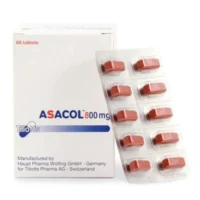Description
Asacol (Mesalazine) Coated Enteric Tablets 400 mg. №100
Ingredients
Each tablet contains 400 mg of mesalazine.
Mechanism of Action
Mesalazine acts locally in the colon by inhibiting inflammatory mediators and promoting mucosal healing, leading to a reduction in ulcerative colitis symptoms.
Pharmacological Properties
Mesalazine exerts its therapeutic effects by targeting inflammation in the colon, without significant systemic side effects commonly seen with other anti-inflammatory drugs.
Indications for Use
Asacol tablets are indicated for the treatment of mild to moderate ulcerative colitis.
Contraindications
Avoid using Asacol if you have a known allergy to mesalazine or salicylates.
Side Effects
Common side effects of Asacol may include nausea, abdominal pain, and headache. Contact your healthcare provider if you experience persistent or severe side effects.
Usage Instructions
The typical dosage is 2 to 4 tablets taken three times daily. Swallow the tablets whole with water; do not crush or chew them.
Benefits Compared to Analogues
Asacol has shown comparable effectiveness to other medications for ulcerative colitis treatment, with a lower risk of adverse effects, as demonstrated in clinical trials.
Suitable Patient Groups
Asacol can be used in various patient populations, including children and the elderly, under appropriate medical supervision.
Storage and Shelf Life
Store Asacol tablets in a cool, dry place away from moisture. Check the expiration date on the packaging and do not use expired medication.
Packaging Description
Asacol tablets are typically packaged in blister packs containing 100 coated enteric tablets of 400 mg each.
Clinical Evidence and Proven Effectiveness
Studies have confirmed the efficacy of mesalazine in inducing and maintaining remission in ulcerative colitis patients. Research in the Journal of Gastroenterology has shown mesalazine’s ability to reduce colon inflammation and improve disease symptoms.





